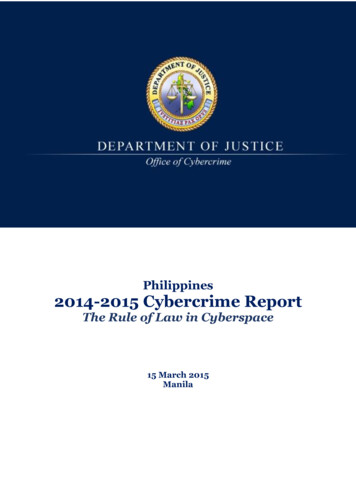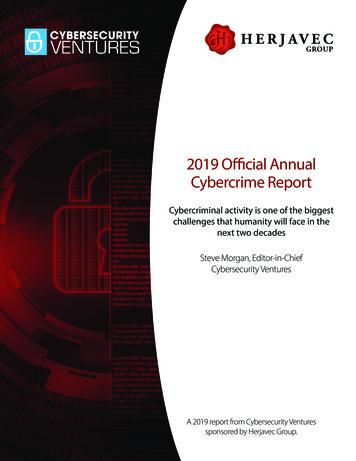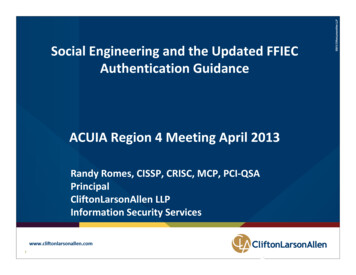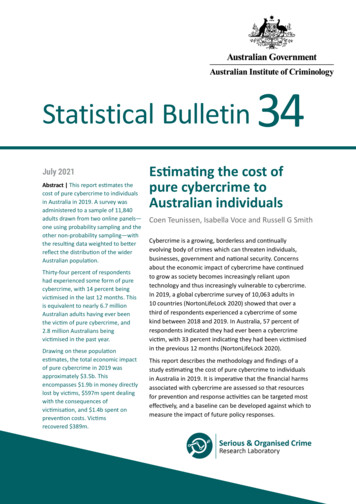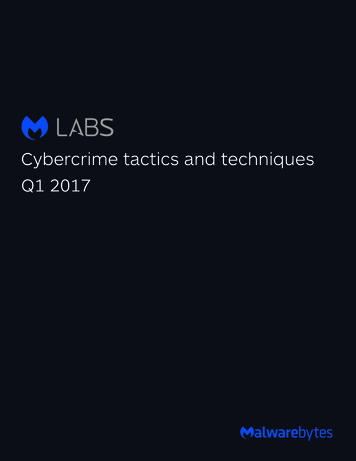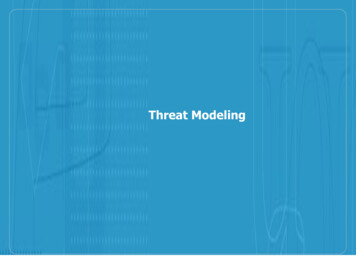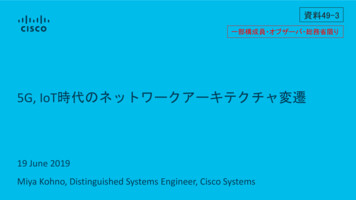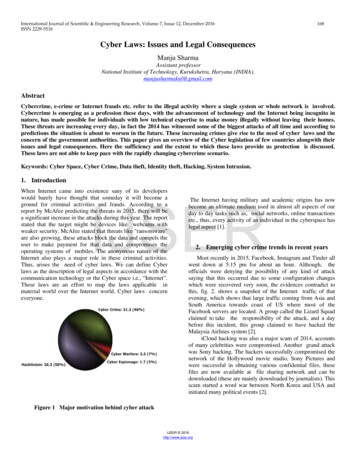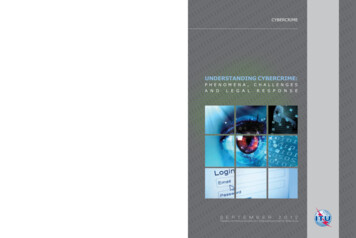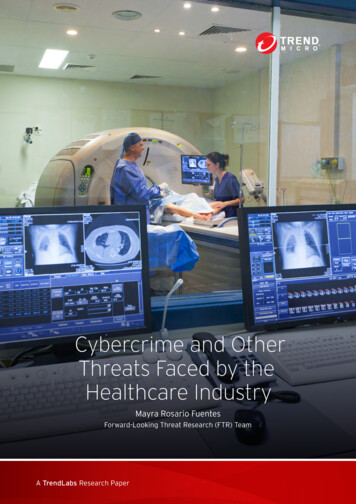
Transcription
Cybercrime and OtherThreats Faced by theHealthcare IndustryMayra Rosario FuentesForward-Looking Threat Research (FTR) TeamA TrendLabs Research Paper
TREND MICRO LEGAL DISCLAIMERThe information provided herein is for general informationContentsand educational purposes only. It is not intended andshould not be construed to constitute legal advice. Theinformation contained herein may not be applicable to allsituations and may not reflect the most current situation.Nothing contained herein should be relied on or actedupon without the benefit of legal advice based on theparticular facts and circumstances presented and nothingherein should be construed otherwise. Trend Microreserves the right to modify the contents of this documentat any time without prior notice.4The Security Issue withElectronic Health RecordsTranslations of any material into other languages areintended solely as a convenience. Translation accuracyis not guaranteed nor implied. If any questions ariserelated to the accuracy of a translation, please refer tothe original language official version of the document. Anydiscrepancies or differences created in the translation arenot binding and have no legal effect for compliance orenforcement purposes.Although Trend Micro uses reasonable efforts to include9Electronic Health Recordsin the Undergroundaccurate and up-to-date information herein, Trend Micromakes no warranties or representations of any kind asto its accuracy, currency, or completeness. You agreethat access to and use of and reliance on this documentand the content thereof is at your own risk. Trend Microdisclaims all warranties of any kind, express or implied.Neither Trend Micro nor any party involved in creating,producing, or delivering this document shall be liablefor any consequence, loss, or damage, including direct,indirect, special, consequential, loss of business profits,or special damages, whatsoever arising out of access to,13How Cybercriminals MakeUse of Electronic HealthRecordsuse of, or inability to use, or in connection with the use ofthis document, or any errors or omissions in the contentthereof. Use of this information constitutes acceptance foruse in an “as is” condition.18Exposed HealthcareSystems31Conclusion32Appendix: Data Breachesin the Healthcare Sector
The healthcare sector has been the industry with the highest number of databreaches, followed by the government and retail sectors. In 2015, a totalof 113.2 million healthcare-related records were stolen, which remains thehighest number of stolen data from a breach in the healthcare industry sofar.1 That year, however, was not the only time healthcare institutions weretargeted. As early as 2012, healthcare institutions became victims of cyberattacks. The most common kind of attack is related to cybercrime in the formof data breaches. But there are other possible pathways for malicious actorsto do harm to this poorly protected industry.The biggest impact of health care record theft is noticeable in countries wheremost citizens have health insurance. In 2016, 91% of the U.S. population hadhealth insurance. Therefore, any major breach in a healthcare organization inthe U.S. could affect a great number of citizens.One way that individuals are affected by a breach is when stolen personaldata are used by cybercriminals to procure drugs, commit tax fraud, stealidentities and commit other fraudulent acts. Victims of a data breach may noteven be aware that their personal data has been stolen, or perhaps is beingused in criminal acts.The Internet of Things (IoT) simplifies a lot of processes and is celebratedas a great connector. However, this increased connectivity also has somepitfalls. With the help of Shodan, a search engine that lets you search forinternet-connected devices, we explored what healthcare-related devicesand networks are visible to practically anyone.In this paper, we discuss several aspects of the healthcare threat surface. Inthe first part, we look at how the healthcare sector has evolved as a preferredtarget for cybercriminals. We try to understand how stolen medical recordsare monetized after a breach, what types of data are stolen, how much theyare sold for on the underground markets, and how cybercriminals make useof them. The second part of this paper is dedicated to the analysis of Shodanscan data which reveals what healthcare-related devices and networks areconnected to the internet and are visible to everyone, including cybercriminals.Exposure on the internet, however, does not mean that these devices havebeen compromised or are even actually vulnerable to exploitation. In thisresearch we purely show that certain devices are exposed online, whichmakes it easier to exploit if a vulnerability in the device software is found.
The Security Issue withElectronic Health RecordsAn electronic health record (EHR) is a digital version of a patient’s medical record. Every EHR containsinformation about a patient’s demographics, insurance information, mailing address, Social Securitynumber, birthdate, notes from prescribing doctor, lifestyle details, medications, vital signs, family medicalhistory, immunization records, laboratory results and even radiology reports among others. Other thanmedical records, EHRs may also contain billing information such as credit card details and invoices.An EHR is accessed by EHR management software. In the U.S. programs such as PrognoCIS, NueMD,McKesson, Allscripts, Cerner, Praxis EMR, Athena Health, GE Healthcare, eClinicalWorks, and SRS EHRare used. Internationally, EHR programs such as Allscripts Healthcare Solutions, Inc., Athena Health, Inc.Cerner Corporation, CPSI, Epic Systems, eClinicalWorks, GE Healthcare, Greenway Health LLC, MedicalInformation Technology, Inc., McKesson Corporation, and NextGen and OpenMRS are utilized.Figure 1. A screenshot of a compromised EHR from a U.S. healthcare facility24 Cybercrime and Other Threats Faced by the Healthcare Industry
Figure 2. A screenshot of the McKesson EHR software3Given the contents of an EHR and its capacity to hold financial and credit card records, healthcareorganizations become targets of cybercriminals who aim to steal personal identifiable information (PII),as well as financial information. But unlike other data breaches, cybercriminals have found more ways touse information from EHRs aside from selling the data in bulk in underground markets. With this in mind,further steps have to be taken to keep health care data secure.Healthcare Laws Protecting Data and UsersThe Health Information Technology for Economic and Clinical Health (HITECH) Act, under the AmericanRecovery and Reinvestment Act of 2009 (ARRA) made it a federal mandate for healthcare institutionsto adopt the use of electronic health records systems to improve health care. This also reduces cost byreplacing physical documentation with electronic ones. There was also a series of financial-incentiveprograms that were established for the implementation, upgrade, maintenance, and smooth operation ofEHR technology.In terms of usage, there were 513,811 health care providers that received payment for participating inthe Medicare and Medicaid Electronic Health Record (EHR) Incentive Programs in 2016. Between May2011 and December 2016, more than US 35 billion in Medicare and Medicaid EHR Incentive Programpayments were made.45 Cybercrime and Other Threats Faced by the Healthcare Industry
While incentive programs were provided for the use of EHR systems, there was no guidance regardingthe security of these EHR systems.5 On top of that, healthcare facilities lacked the budget, the manpower,and the expertise to manage data breaches caused by evolving cyber threats. Despite Health InsurancePortability and Accountability Act (HIPAA) laws being designed to protect patients against loss, theft orthe disclosure of patients’ sensitive medical information, there remains a lot of healthcare entities thathave not implemented basic safeguards like encrypting data or using a two-factor authentication process,which are risk management tactics that were recommended since 2006. In fact, the HIPAA recommendedthe use of strong encryption and for Secure Sockets Layer (SSL) to be the minimum requirement for allinternet-based systems, including corporate web email systems.6According to a survey by the Healthcare Information and Management System Society (HIMSS), about68.1% of hospital providers and less than half of medical practice providers encrypt data in transit andare sending protected health information in the clear. As for stationary data, 61.3% of hospitals areencrypting stored data and 48.4% of medical practice providers are encrypting stored data.7 Withoutencryption, the data in transit can be captured through eavesdropping, packet sniffing, or through othermethods.The Ponemon Institute’s Sixth Annual Benchmark Study on Privacy and Security Health Care Data in May2016, made the following points: About half of all organizations have little or no confidence that they can detect all patient data lossor theft. The majority of healthcare organizations still lack sufficient budget for security that will be used tocurtail or minimize data breach incidents. A majority also believes that their incident response processhas inadequate funding and resources. The majority of healthcare organizations have not invested in the technologies necessary to mitigatea data breach, nor have hired enough skilled IT security practitioners. The budget for security of most healthcare organizations has declined by 10%, while that of morethan half of the organizations have remained static and most healthcare organizations believe theydon’t have the budget to properly protect data. 8Breaches of EHR SoftwareWhile there are existing laws that are designed to protect a patient’s privacy, like the HIPAA, healthcarefacilities still have to enact basic safeguards to protect a patient’s information. Unfortunately, a lot ofhealthcare entities today still do not encrypt data or use a two-factor authentication process. In addition,healthcare institutions also lack the resources, and/ or the expertise, to deal with data breaches and othercyber attacks.6 Cybercrime and Other Threats Faced by the Healthcare Industry
EHRs are targets of cybercriminals since they contain PII that do not expire. For example, Social Securitynumbers can be used multiple times for malicious intent, making them more valuable compared to otherPII. More often than not, cybercriminals target the EHR software and vendors themselves. Attackingcloud-based EHR software vendors can allow cybercriminals access to multiple client databases in asingle operation.These databases may be exposed to vulnerabilities such as SQL injections, cross-sitescripting and are also exposed via the internet to practically anyone.Bizmatics, a California-based company offers locally hosted and cloud-based EHR software. Bizmaticsproduced the PrognoCIS software that was comprised in January 2015 when a malware in their serverallowed hackers to gain access to the data. PrognoCIS is an EHR software that includes an online patientportal that allows patients to request appointments, order medicine refills, review their medical recordsand communicate with the doctor’s office. It is believed that 300,000 individuals were affected in thisattack alone. 9The Bizmatics server contained patients’ medical records with information such as names, addresses,dates of birth, insurance information, Social Security numbers, and various types of clinical documentation.At least 17 healthcare facilities were compromised. The clients that reported breaches were the ENT andAllergy Center in Arkansas, North Ottawa Community Health System, Vincent Vein Center Grand JunctionP.C., California Health and Longevity Institute, Lafayette Pain Care PC, Eye Associates of Pinellas, PainTreatment Centers of America, Integrated Health Solutions PC, Illinois Valley Podiatry Group, CompleteFamily Foot Care, Family Medicine of Weston, HealthCare Consultants, The Vein Doctor, Mark AnthonyQuintero M.D. L.L.C. and an undisclosed company represented by the law firm Allen Dell.10Also in 2015, Medical Informatics Engineering suffered from data theft when their web-based EHR softwareNoMoreClipboard exposed 3.9 million of patient data. The stolen data included patients’ names, mailingaddresses, email addresses, dates of birth, Social Security numbers, lab results and voice-recordedreports.117 Cybercrime and Other Threats Faced by the Healthcare Industry
Why steal EHR?EHR data is unique in a way that it includes PII, along with medical, insurance, and financial information. Toget a better grasp of an EHR’s value, let’s compare an EHR breach with a non-EHR breach. In September2016, Yahoo disclosed a data breach that occurred in 2014 wherein 500 million user accounts werestolen. The PII that were compromised included users’ names, emails, telephone numbers, date of birth,hashed passwords, and security questions and answers.12 While there is a market for PII in the criminalunderground, financial information such as those found in EHRs are worth more.Aside from financial information, an EHR contains PII that cannot be replaced. This poses a big challengewhen PII is stolen and peddled in the underground market. By combining portions of PII, cybercriminalsare able to unlawfully obtain wares. For example, date of birth, medical insurance ID, and a Social Securitynumber can be combined to acquire medical insurance.A major reason why cybercriminals can successfully steal EHRs is the lack of safeguards implementedin healthcare institutions with regard to their digital assets. Hospitals and other healthcare organizationsmay prioritize operations and efficiency of the facility over cybersecurity. Very often hospitals and/orhealthcare organizations may not be equipped with the right staff to handle digital threats and basicsecurity methods such as a two-factor authentication or encryption.8 Cybercrime and Other Threats Faced by the Healthcare Industry
Electronic Health RecordsTraded in the UndergroundIn the past three years, stealing payment card data became very popular due to the success of point-ofsale (PoS) malware. However, cybercriminals can only use the stolen credit cards before the card expires,is maxed out or cancelled. In contrast, an EHR database containing PII that do not expire—such as SocialSecurity numbers—can be used multiple times for malicious intent. Stolen EHR can be used to acquireprescription drugs, receive medical care, falsify insurance claims, file fraudulent tax returns, open creditaccounts, obtain official government-issued documents such as passports, driver’s licenses, and evencreate new identities.EHRs can be sold as a complete EHR database or the information can be sold in portions. Theseportions are of course the different PII elements which include Social Security numbers, addresses, etc.Popular Dark Web marketplaces include TheRealDeal, AlphaBay, Valhalla, Apple Market, Python Market,Dream Market and Silk Road. In the following, we have compiled different items that we saw in someunderground marketplaces (see figures below).Medical Insurance ID dataFigure 3. An AlphaBay ad selling medical insurance cards in August 20169 Cybercrime and Other Threats Faced by the Healthcare Industry
Alphabay vendors are selling medical insurance cards that can be used to receive medical care and orderprescription refills through mail orders. Figure 3 shows a threat actor selling stolen medical insurance IDcards for as low as US 1 per ID.Figure 4. An AplhaBay ad selling full records of U.S. citizens with medical data on 4 November 2016The figure above shows a hacker selling “full records” of U.S. citizens, which feature specific medicaldata and the preferred health insurance. Prices start at 99 cents per person but the cybercriminal offersdiscounts if people buy in bulk.Figure 5. AlphaBay advertisement for Medical insurance ID10 Cybercrime and Other Threats Faced by the Healthcare Industry
This screenshot shows a hacker selling comprehensive medical profiles on AlphaBay. These profiles wereobtained from an EHR database that contained a patient’s name, Social Security number, address, dateof last visit, date of next appointment, follow-up treatment dates, date of birth, and health insurance IDnumbers. Prices per patient information item start at US 5.Figure 6. Alphabay advertisement for UK health insurance ID and driver’s license on 4 November 2016The image above shows a cybercriminal selling United Kingdom health insurance ID numbers along withthe corresponding driver’s license, and the full name, address, and email of deceased citizens. Prices areUS 20.43 per 10 records or US 3.34 for one record.Figure 7. Advertisement for a New York driver’s license from AlphaBay marketplace11 Cybercrime and Other Threats Faced by the Healthcare Industry
Figure 7 shows how EHR PII information can be used to obtain official government documents, such asthe driver’s licenses above for New York City. The hacker sells multiple official government indentificationdocuments such as passports and birth certificates. Prices for driver’s licenses start at US 170.Figure 8. An AlphaBay advertisement that sells new identities using stolen dataMeanwhile, this screenshot above also shows the hacker selling a farmed identity. Farmed identities arecreated through the use of stolen personal data that includes Social Security numbers, dates of birth,education records, employment records, health insurance, car insurance and passports from individualsthat are no longer using the information–which are usually dead people. Once EHRs have been collected,cybercriminals essentially have a database full of stolen information that they can sell at a high priceanytime and in any configuration that sells best on the underground market. The minimum price of onefarmed identity starts at US 1,000. Cybercriminals can purchase add-ons from the vendors such as birthcertificates and passports.12 Cybercrime and Other Threats Faced by the Healthcare Industry
How do Criminals MakeUse of Electronic HealthRecords?Because of the special nature of the information found in EHRs, cybercriminals are able to offer nicheproducts and services by combining certain data found in an EHR. These products and services are: Prescription information that can be used for the procurement of drugs Irreplaceable PII, such as Social Security numbers and dates of birth, can be used to create fakeidentities PII such as Social Security numbers and Medicare insurance ID are used to obtain medical insurance Birth certificates can be created with stolen medical records and personal data like birthdates A combination of Social Security numbers and addresses can help cybercriminals file fraudulenttax returnsDrug ProcurementPurchasing EHR profiles with prescription information can help cybercriminals order prescription drugsthrough mail-order programs used by the health insurance provider. Later on, these medications can besold in Dark Web marketplaces for a large profit. By having the medical ID, a cybercriminal can create orupdate the address on file for the profile they have purchased and then send the medication to their homesby using the credit card information stored on file from the original account holder. Sales of prescriptiondrugs are popular in multiple Dark Web marketplaces.According to Surescripts, an online software that supports e-prescription, electronic prescribing ofcontrolled substances has increased 7.5 times between 2014 and 2015. Some states, such as NewYork, created mandates where all prescriptions of controlled substances must be processed throughe-prescribing software. The survey found that between 3% and 9% of drug diversions occurred becauseof forged and/or stolen paper prescription. Over 77% of prescriptions have gone digital last year.1313 Cybercrime and Other Threats Faced by the Healthcare Industry
Figure 9. Drug Enforcement Administration (DEA)-controlled drugssold on Valhalla on 19 September 2016Figure 9 shows Valhalla’s section of medications that are available for purchase. This section includescontrolled substances such as the anti-anxiety medications Xanax and Klonopin.Figure 10. Advertisement for Ambien medication on Vahalla14 Cybercrime and Other Threats Faced by the Healthcare Industry
Figure 10 is an advertisement for Ambien, a controlled medication that is usually prescribed to helppeople with sleep disorders. Ambien is also known to be abused by many users. The number of Ambienrelated emergency visits in the U.S. has gone up according to a report from the Substance Abuse andMental Health Services Administration (SAMHSA). It is estimated that between 2006 and 2011, 38 millionAmbien prescriptions were written. A survey also revealed that there were more than half a million peoplein the U.S. who abused Ambien.14Figure 11. AlphaBay forum discussion asking for DEA numbers in order to obtain fraudulent prescriptionIn the figure above, a user can be seen asking members of AlphaBay for DEA numbers in order to obtainfraudulent prescriptions. Fraudulent prescriptions can be used to resell drugs on the Dark Web or forpersonal drug use.Identity TheftA study by the Ponemon Institute in 2014 identified 500,000 as the number of victims of medical identityfraud. In 2015 those numbers rose to 22%, without adding the Anthem breach. In terms of resolvingfraud issues, credit cards breaches have financial lability limited to US 50 per card. In the health industry,however, 65% of victims of medical identity theft had to pay an average of US 13,500 to resolve thecrime–with costs covering the services of creditors and legal counsel. Credit cards can be easilycancelled and replaced but health care data such as Social Security numbers, and birthdates, arepermanent–which means the data will live forever and that cybercriminals may reuse such information fora variety of purposes.1515 Cybercrime and Other Threats Faced by the Healthcare Industry
According to the Consumer Financial Protection Bureau, roughly half of all collection accounts on creditreports are due to medical debt, which can be incurred by the other person using the stolen identity. Asingle collection debt account can make a credit score drop 50 to 100 points.16 Credit bureaus will wait180 days before adding medical debt to your report17 but unlike credit card crimes medical identity theftcan take more than three months after a crime has been committed to be reported and 30% will neverknow they are victims.When a victim’s medical ID is used by another person to receive health services, the EHR is also modified–sometimes affecting critical information such as a person’s blood type, list of known allergies, and currentmedications. Detecting medical identity theft is not as easy as detecting credit card crimes. As a result,about 20% of victims received the wrong diagnosis or perhaps proper care was delayed because theirEHR information was used and altered.18Medical InsuranceFigure 12. An Alphabay advertisement for California State Medicare Insurance CardsIn Figure 12, a hacker is seen selling individual profiles that contain Social Security numbers, dates ofbirth, and Medicare insurance ID numbers that can be used to obtain medical insurance. The hacker alsohappens to sell the profiles that have approved prescriptions in Los Angeles, California. Even though theinformation is from 2015, the vendor assures buyers that the medical information is still active. At only 50cents per profile, cybercriminals can buy multiple profiles and perform several test purchases.16 Cybercrime and Other Threats Faced by the Healthcare Industry
Birth CertificatesFigure 13. An AlphaBay advertisement for birth certificates found on 15 September 2016Using data stolen from medical records, birthdates can be obtained and sold individually to obtain a copyof a real birth certificate. In the above figure, we can see an advertisement for birth certificates starting atUS 500 per person.Fraudulent Tax ReturnsFigure 14. An advertisement found in Valhalla offering services to commit income tax fraudIn the last two years the number of cybercriminals committing tax fraud, through the use of stolen personaldata found in EHRs, increased.19 As a result, Turbo Tax–a program used for filing taxes in the U.S.–hadto temporarily suspend state tax filings to investigate the increasing number of fraud cases. The imageabove shows the vendor selling 25 income tax returns at US 15 per tax return.17 Cybercrime and Other Threats Faced by the Healthcare Industry
Exposed HealthcareSystemsInternet-connected devices revealing EHR systemsFor this research, we conducted queries on Shodan, a search engine that indexes internet-connecteddevices. Search results revealed EHR systems, healthcare facilities, medical equipment, and networksthat are vulnerable to cybercriminals. As part of the process, Shodan gathers the banner that displays thecurrent services running on the device. Sometimes these banners can provide version numbers of thesoftware running on a device. The banner also displays meta-data such as operating systems, system filestructures, folders, IP addresses, geographical locations, hostnames and more.20Figure 15. A search on Shodan for the Cerner EHR software displays the version numbers,folders, and the software running on the devices as of 24 October 2016.18 Cybercrime and Other Threats Faced by the Healthcare Industry
Shodan allows searches that target doctors with specializations like dermatologists and oncologists.Shodan is also able to search by services or programs running on target computers, EHR vendors, andVPNs. Searches of connected printers and webcams can also be conducted. To log in and make useof these printers and/or webcams, cybercriminals may use websites such as Datarecovery.com andDefaultpasswords.com to see if default passwords were never changed. Hundreds of applications areknown to be deployed with default passwords, and are not always changed before they are plugged intoa network.Unsecured DevicesHaving unsecured IoT devices in both healthcare institutions, as well as offices of EHR developers, canleave devices vulnerable to attacks. Exploitation of the Universal Plug and Play Protocol (UPnP) can givecybercriminals access to these devices. In turn, attackers may change the configuration of these devicesin a way that lets them collect information. These unsecured devices can also be used as a gateway forcybercriminals to break into their target’s network.21Figure 16. Unsecured printer being used at a healthcare organization19 Cybercrime and Other Threats Faced by the Healthcare Industry
Figure 17. A screenshot of the system log and network information from an exposed printerFigure 18. A printer’s control panel of a hospital20 Cybercrime and Other Threats Faced by the Healthcare Industry
Figure 19. A screenshot showing a printer’s history used at a healthcare organizationFigure 20. Printer specifications used at a healthcare organization21 Cybercrime and Other Threats Faced by the Healthcare Industry
Remote Desktop ProtocolsWhen administrators have log-in names as their real names in remote desktop protocols (RDP), maliciousactors may resort to social engineering tactics to trick the target into giving information about theirpassword. Attackers may also go through the target’s social network accounts to guess the password.Figure 21. RDP of a healthcare organizationFigure 22. RDP for a healthcare organization22 Cybercrime and Other Threats Faced by the Healthcare Industry
Industrial Control SystemsHealthcare organizations that use Industrial Control Systems (ICS) to run its facilities are exposed to somepitfalls. This includes an ICS running on legacy systems such as Windows XP. Cybercriminals may alsobreak into an ICS system by acquiring log-in credentials.Figure 23. A screenshot showing that a healthcare organization’s ICSis running on Windows XPFigure 24. Healthcare Organization’s Server ICS login23 Cybercrime and Other Threats Faced by the Healthcare Industry
Communication Tools and Other Online VulnerabilitiesAttackers are constantly on the lookout for ways to break into their target’s database. Meanwhile healthcareinstitutions or EHR software companies may host meetings using third party software; there are still a lotof organizations that use their own websites to host and join meetings. However, if these meetings use adefault password, hackers can access these meetings too. Since most systems do not vet if the personlisted is who they are, the host of the meeting may not notice if there are unauthorized people listeningto their calls.Figure 25. Exposed web conference meeting site that allows other usersto host meetings at a healthcare organizationFor meetings that utilize conferencing systems, attackers can turn those exposed systems or equipmentinto video-surveillance units. Then hackers can use them to snoop for information, record videoconferences, or even privately or publicly broadcast a meeting.24 Cybercrime and Other Threats Faced by the Healthcare Industry
Figure 26. Exposed Polycom conference video from a healthcare organizationSome EHRs can be accessed through the IP address of the vendor. Hackers can use brute force attacksagainst the log-in credentials to break into the system. Sites that store or give access to EHR shouldideally be accessible through an internal network or VPN.Figure 27. PrognoCIS exposing the EHR system’s log-in page25 Cybercrime and Other Threats Faced by the Healthcare Industry
Exposed U.S. HospitalsShodan U.S. scan data for February 2017 contains a total of 123,098,618 records, with 36,116 recordsbeing related to healthcare. Out of the 36,116 healthcare-related records, 6,502 originated from the top 10U.S. cities w
McKesson, Allscripts, Cerner, Praxis EMR, Athena Health, GE Healthcare, eClinicalWorks, and SRS EHR are used. Internationally, EHR programs such as Allscripts Healthcare Solutions, Inc., Athena Health, Inc. . cloud-based EHR software vendors can allow cybercriminals access to multiple client databases in a
